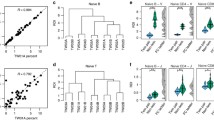Abstract
Further evidence for quantitative variation in H-2-antigen expression in F1 hybrids is described. Spleen cells from nine different F1 hybrids were compared with parental strain cells for differences in H-2K- and H-2D-antigen expression by quantitative absorption analysis and in an125I-radioimmunoassay using anti-H-2 sera. Some K and D antigens are expressed in two to three times smaller amounts in F1 hybrids, while others are approximately equally expressed. There was no evidence for eitherI-region control or parental influence in the genetic control of H-2-antigen expression. Expression of K and D antigens in an F1 hybrid (compared with parental cells) is dependent on theK andD allelic composition of the hybrid, in that some alleles tend to dominate over others. In four different F1 hybrids,K k was more strongly expressed thanK b, while, in other F1 hybrids,K d predominated over bothK k andK b. Similarly,D b dominated overD d in five different F1 hybrids, while no obvious dominance pattern was found in F1 hybrids carryingD k.
Similar content being viewed by others
References
von Boehmer, H., Fathman, C. G., and Haas, W.:H-2 gene complementation in cytotoxic T-cell responses of female against male cells.Eur. J. Immunol. 7: 443–447, 1977
Cullen, S. E., Schwartz, B. D., Nathenson, S. G., and Cherry, M.: The molecular basis of codominant expression of the histocompatibility-2 genetic region.Proc. Natl. Acad. Sci. U.S.A. 69: 1394–1397, 1972
Doherty, P. C. and Zinkernagel, R. M.: Enhanced immunological surveillance in mice heterozygous at theH-2 gene complex.Nature 256: 50–52, 1975
Demánt, P. Néauport-Sautès, C., and Joskowitz, M.: A three locus model for the “classical” H-2 antigens.Tissue Antigens 10: 252, 1977
Fathman, C. G. and Nabholz, M.:In vitro secondary mixed leukocyte reaction (MLR). II. Interaction MLR determinants expressed by F1 cells.Eur. J. Immunol. 7: 370–374, 1977
Gordon, R. D., Samelson, L. E., and Simpson, E.: Selective response to H-Y antigen by F1 female mice sensitized to F1 male cells.J. Exp. Med. 146: 606–610, 1977
Hurme, M., Hetherington, C. M., Chandler, P. R., Gordon, R. D., and Simpson, E.: Cytotoxic T-cell responses to H-Y:Ir genes and associative antigens map inH-2.Immunogenetics 5: 453–459, 1977
Ishikawa, H. and Dutton, R. W.: Primaryin vitro cytotoxic response of F1, T lymphocytes against parental antigens.J. Immunol. 122: 529–536, 1979
Jones, P. P., Murphy, D. B., and McDevitt, H. O.: Two-gene control of the expression of a murine la antigen.J. Exp. Med. 148: 925–939, 1978
Klein, J.:Biology of the Mouse Histocompatibility-2 Complex. Springer-Verlag, Berlin, 1975
McKenzie, I. F. C. and Snell, G. D.: Comparative immunogenicity and enhance-ability of individual H-2K and H-2D specificities of the murine histocompatibilily complex.J. Exp. Med. 138: 250–277, 1973
McKenzie, I. F. C., Morgan, G. M., Melvold, A. W., and Kohn, H. I.: Serological and complementation studies in four C57BL/6H-2 mutants.Immunogenetics 3: 241–251, 1976
McKenzie, I. F. C., Morgan, G. M., Melvold, R., and Kohn, H. I.:BALB/c-H-2 db: A newH-2 mutant in BALB/cKh that identifies a locus associated with theD region.Immunogenetics 4: 333–347, 1977
O'Neill, H. C. and Blanden, R. V.: Quantitative differences in the expression of parentally-derived H-2 antigens in F1 hybrid mice affect T-cell responses.J. Exp. Med. 149: 724–731, 1979 a
O'Neill, H. C. and Blanden, R. V.: Variation in H-2 antigen expression in F1 hybrids: Analysis using monoclonal antibodies.Aust. J. Exp. Biol. Med. Sci. 57: 627–635, 1979 b
Shearer, G. M., Schmitt-Verhulst, A., Pettinelli, C. B., Miller, M. W., and Gilheany, P. E.:H-2 linked genetic control of murine T-cell-mediatcd lympholysis to autologous cells modified with low concentrations of trinitrobenzene sulfonate.J. Exp. Med. 149: 1407–1423, 1979
Simpson, E. and Gordon, R. D.: Responsiveness to H-Y antigen IR gene complementation and target cell specificity.Immunol. Rev. 35: 59–75, 1977
Snell, G. D.: T cells, T cell recognition structures, and the major histocompatibility complex.Immunol. Rev. 38: 3–69, 1978
Warner, J. F. and Cudkowicz, G.: F1 hybrid anti-parentalH-2 k cell-mediated lympholysis I. Stimulator and target determinants controlled by theH-2K region.J. Immunol. 122: 575–581, 1979
Author information
Authors and Affiliations
Rights and permissions
About this article
Cite this article
O'Neill, H.C. Quantitative variation in H-2-antigen expression. Immunogenetics 11, 241–254 (1980). https://doi.org/10.1007/BF01567791
Received:
Revised:
Issue Date:
DOI: https://doi.org/10.1007/BF01567791




